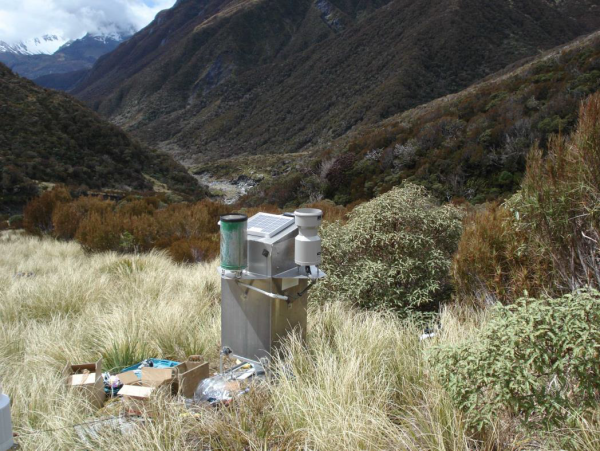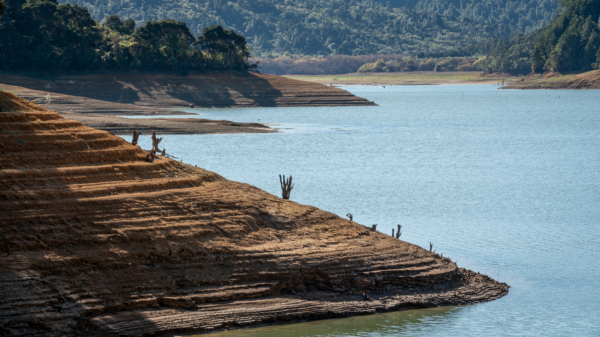Written by Gregor Macara, NIWA Climate Scientist
On this page:
- Measuring extremes
- New Zealand’s highest temperature
- New Zealand’s lowest temperature
- New Zealand’s highest annual rainfall
- New Zealand’s longest dry spell
- Videos
- Activity – write a short story
- Quiz - climate and weather extremes
Download a shorter version of this lesson in PowerPoint or as a PDF or continue below to see the lesson in full.
As we learnt in the previous lesson, New Zealand’s climate can be defined as ‘temperate’ meaning we experience mild weather conditions. However, every so often we experience extreme weather and climate events.
These events are unusual and don’t happen very often – that’s why we call them ‘extreme’. The other reason we call these events extreme is because they can cause impacts that affect our daily lives, such as heavy rain that causes flooding. These events may happen on a single day, or they may occur over a long period of time – for example droughts often develop when we have many weeks in a row without any rainfall.
Measuring extremes
You might head to the beach on a very hot summer day and find your face is flushed and you get sweaty because it is so hot. But how do we know if it is hot enough to be considered ‘extreme’?
For that, we need to have a collection of all historic observations of temperature, rainfall, wind and sunshine. That way, we can compare the temperature we are feeling with all the temperatures that have been recorded in the area and find out how unusual the current temperature is.
In New Zealand, we have measurements of our weather and climate going all the way back to the 1850s.
Originally, these measurements were recorded by hand on paper. But now most of these measurements are made automatically by special weather stations and sent directly to New Zealand’s National Climate Database.
The picture below is one of the earliest handwritten data sheets from Albert Park in Auckland, from 1863! Rainfall and temperature measurements began here in 1853.
New Zealand extremes
So we have well over 100 years of weather and climate measurements that we can use to find out about New Zealand’s extremes.
NIWA has a webpage which lists several of our weather and climate extremes.
Let’s look at some of our temperature and rainfall extremes in more detail"
New Zealand’s highest temperature
The highest temperature recorded in New Zealand is 42.4°C. This was measured in Rangiora, Canterbury, 47 years ago on 7 February 1973.
There were three features that allowed temperatures to get so high on this day: time of year, wind direction and clear skies. Why were these important?
- Time of year: February is one of our summer months and we experience our hottest temperatures during this time of year. The daylight hours are long, the energy received from the sun is at its hottest and the sea surface temperatures surrounding New Zealand are also at their highest allowing our air temperatures to be warmer than at other times of year.
- Wind direction: The wind direction over New Zealand and the Tasman Sea was north-west. This meant hot air from Australia travelled all the way over to New Zealand.
- Clear skies: There were bright, blue skies over eastern Canterbury with very little or no clouds. Although the air was already hot to start with (remember it had been transported from Australia), the bright sunshine heated up the air even more.
New Zealand’s lowest temperature
The lowest temperature recorded in New Zealand is -25.6°C. This was measured in Ranfurly, 117 years ago, on 17 July 1903.
There were three important features that allowed temperatures to get so low on this day: time of year, clear skies and snow on the ground. Why were these important?
- Time of year: July is one of our winter months and we experience our lowest temperatures at this time of year. The daylight hours are shortest (meaning our nights are long), the energy received from the sun is at its lowest and the sea surface temperatures surrounding New Zealand are also lowest – allowing our air temperatures to be colder than at other times of year.
- Clear skies: The weather was calm with clear skies. Clouds act like a blanket trapping heat near the Earth’s surface on winter nights. Because there were no clouds, there was nothing to trap the heat, so it escaped away from the Earth’s surface cooling it. Because the winter nights are long, this process continued for many hours and allowed the temperature to become very cold.
- Snow on the ground: In the days leading up to 17 July 1903, there had beenvery heavy snowfall in Central Otago. Snow can act like a mirror, by reflecting the energy from the sun away from the Earth’s surface. This stops the air temperature warming as much as usual during the day. As a result, the temperature was already very low by night-time and only got colder due to the clear skies. In Ranfurly, the snow was reported to be 60 cm deep.
The picture below shows the town of St Bathans in Central Otago during the July 1903 cold snap. It’s very rare to get such heavy snowfalls these days!
Street scene in snow, St Bathans, Central Otago, photographed in July 1903 by F M Pyle. Credit: National Library
It is worth keeping in mind that extreme climate and weather events for New Zealand may not necessarily be considered extreme when compared to other parts of the world. For example, we think that a 40°C day is extreme but, in some places, such as Dubai, 40°C is just another summer day.
The highest temperature ever recorded on Earth is 56.7°C in Furnace Creek (USA) on 10 July 1913. The lowest temperature recorded on Earth is -89.2°C in Vostok (Antarctica) on 21 July 1983. Other climate and weather extremes from around the world can be viewed online here.
New Zealand’s highest annual rainfall
The highest annual rainfall occurred at a weather station at the Cropp River (in the mountains south of Hokitika). An incredible 16,617mm of rainfall was recorded for the year 1998 – equivalent to the height of eight classroom doors. This is the amount of rainfall Auckland usually records over 15 years!
The Cropp River is one of the wettest places in New Zealand. As we learnt in the previous lesson, westerly winds hit the Southern Alps and dump huge amounts of rain here – a process called orographic rainfall. The Cropp River climate station is shown in the photo below.
When lots of rain falls in a short period of time, it can often cause major problems; such as flooding which impacts towns and houses and slips which can cause major road closures. It can also overwhelm our stormwater and wastewater systems causing dirty water to spill into the ocean.
New Zealand’s longest dry spell
From 8 February 1939, Wai-iti (Marlborough) observed 71 days in a row without any rain - New Zealand’s longest dry spell on record.
Very long dry spells can result in droughts, which have significant impacts, particularly for farmers. Without rain, the grass can’t grow meaning there is less feed for the animals. As a result, farmers often have to buy in supplementary feed so their animals don’t go hungry, or send their animals off to other areas of the country not in drought. Either way, it can become a very expensive and stressful time for farmers.
It isn’t only farmers that feel the impact of long dry spells and drought. In our cities, much of the water we use comes from rivers and reservoirs. These rely on regular rainfall to maintain a steady supply of water for people in the city to use. However, during long dry spells the amount of water we take from rivers and reservoirs can be much greater than what is replaced with rainmeaning our water storage levels fall. If storage levels continue to fall, then authorities may tell us to reduce our water usage. Under worst-case scenarios, we may run out of water and have to rely on local authorities to deliver water in trucks.
The picture below is of one of Auckland’s reservoirs during May 2020, when the city experienced its first water crisis in 25 years.
Credit: Stu Mackay, NIWA
Videos
Floods - The Dr. Binocs Show
Drought - The Dr. Binocs Show
Activity – write a short story
Interview your parents or another adult and ask them to remember the most extreme weather or climate experience they have had in their lifetimes. Once you have interviewed them, write a short story about it, imagining that you were them experiencing the extreme weather or climate event.
Some questions you could ask them are:
- What was the most extreme weather or climate event that you can remember? Was it a flood, a drought, a snowstorm, a heatwave, or something else?
- How old were you when it happened?
- Where did the event occur?
- What do you remember about it? How did the extreme weather or climate event impact their life (e.g. was there damage around their house, was it harder to get to school or work, did they have to save water?)
Quiz - climate and weather extremes
Check out our weather and climate extremes quiz over on Kahoot.
(The quiz works best on kahoot, but if you prefer a text version, you can download it as a PDF here).





